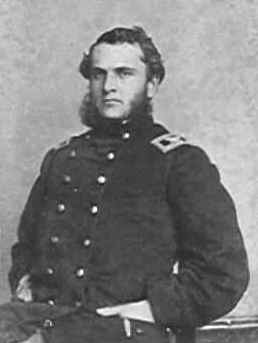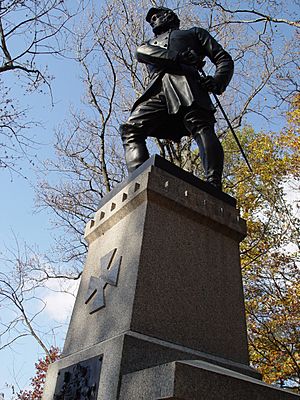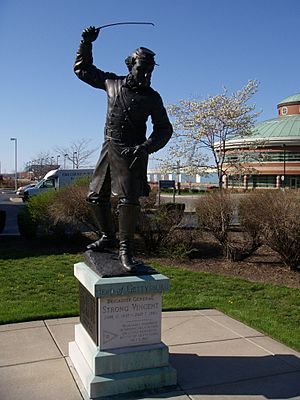Strong Vincent facts for kids
Quick facts for kids
Strong Vincent
|
|
|---|---|

Vincent as a colonel
|
|
| Born | June 17, 1837 Waterford, Pennsylvania |
| Died | July 7, 1863 (aged 26) Gettysburg, Pennsylvania |
| Buried |
Erie Cemetery, Erie, Pennsylvania
|
| Allegiance | United States of America |
| Service/ |
United States Army Union Army |
| Years of service | 1861–1863 |
| Rank | |
| Unit | Erie Regiment |
| Commands held | 83rd Pennsylvania Infantry 3rd Brigade, 1st Division, V Corps |
| Battles/wars | |
Strong Vincent (June 17, 1837 – July 7, 1863) was a lawyer who became famous as a U.S. Army officer during the American Civil War. He was mortally wounded while leading his brigade during the fighting at Little Round Top on the second day of the Battle of Gettysburg, and died five days later.
Early life and education
Vincent was born in Waterford, Pennsylvania, son of iron foundryman B. B. Vincent and Sarah Ann (née) Strong. He attended Trinity College and Harvard University, graduating in 1859. He practiced law in Erie, Pennsylvania.
American Civil War
At the start of the American Civil War, Vincent joined the Pennsylvania Militia as an adjutant and first lieutenant of the Erie Regiment. On September 14, 1861, he was commissioned lieutenant colonel of the 83rd Pennsylvania Infantry and was promoted to colonel the following June. After the death of his regimental commander in the Seven Days Battles (at the Battle of Gaines's Mill), Vincent assumed command of the regiment. He developed malaria on the Virginia Peninsula and was on medical leave until the Battle of Fredericksburg in December 1862. On May 20, 1863, he assumed command of the 3rd Brigade, 1st Division, V Corps, Army of the Potomac, replacing his brigade commander, who resigned after the Battle of Chancellorsville.

At the Battle of Gettysburg, 26-year-old Vincent and his brigade arrived on July 2, 1863. He had started the Gettysburg Campaign knowing that his young wife, Elizabeth H. Carter, whom he had married on the day he enlisted in the army, was pregnant with their first child. He had written her, "If I fall, remember you have given your husband to the most righteous cause that ever widowed a woman."
Maj. Gen. Daniel E. Sickles of the III Corps had deviated from his orders, moving his corps to a position that left undefended a significant terrain feature: Little Round Top. The chief engineer of the Army of the Potomac, Brig. Gen. Gouverneur K. Warren, recognized the tactical importance of the hill and urgently sought Union troops to occupy it before the Confederates could. A staff officer sent by Warren encountered Vincent's brigade nearby. Vincent, without consulting his superior officers, decided that his brigade was in the ideal position to defend Little Round Top, saying "I will take the responsibility to take my brigade there." Pvt. Oliver Willcox Norton, Vincent's brigade standard bearer and bugler, later wrote that he and Vincent made a reconnaissance of the Confederate forces as the brigade was moving into position.
One of Vincent's regiments, the 20th Maine, led by Colonel Joshua Lawrence Chamberlain, has received most of the fame for the defense of Little Round Top, but there is little doubt that the efforts and bravery of Vincent were instrumental in the eventual Union victory. Vincent impressed upon Chamberlain the importance of his position on the brigade's left flank and then he left to attend to the brigade's right flank. There, the 16th Michigan Infantry was starting to yield to enemy pressure. Mounting a large boulder, Vincent brandished a riding crop given to him by his wife and shouted to his men "Don't give an inch!" A bullet struck him and he fell. Due to the determination of the 20th Maine, the 44th New York, the 140th New York Volunteer Infantry Regiment, the 83rd Pennsylvania and the 16th Michigan Infantry, the Union line held against the Confederate onslaught. Vincent was carried from the hill to a nearby farm, where he lay dying for the next five days, unable to be transported home due to the severity of his injury.
The commander of the Army of the Potomac, Maj. Gen. George G. Meade, recommended Vincent for promotion to brigadier general on the evening of July 2. The promotion was dated July 3, 1863, but it is doubtful that Vincent knew about the honor before he died (although Pvt. Oliver Willcox Norton in Army Letters 1861-1865 writes "His commission as Brigadier General was read to him on his deathbed.") Vincent's wife gave birth to a baby girl two months later, who died before reaching the age of one and is buried next to her father.
His corps commander, Maj. Gen. George Sykes, described Vincent's actions in his official report from the battle:
Night closed the fight. The key of the battle-field was in our possession intact. Vincent, Weed, and Hazlett, chiefs lamented throughout the corps and army, sealed with their lives the spot intrusted to their keeping, and on which so much depended.... General Weed and Colonel Vincent, officers of rare promise, gave their lives to their country.
– George Sykes, report on the Battle of Gettysburg
Legacy
Vincent is buried in Erie Cemetery in Erie. He is memorialized by a statue on the 83rd Pennsylvania monument on Little Round Top, by a statue erected in 1997 at Blasco Memorial Library, Erie, and by Strong Vincent Middle School in Erie. The portion of Little Round Top to the southeast of Sykes Avenue on the Gettysburg Battlefield is known as "Vincent's Spur". The 1-112 Infantry of the Pennsylvania Army National Guard stationed in Cambridge Springs uses the call sign "STRONG" in recognition of Vincent's courage, determination and sacrifice.



